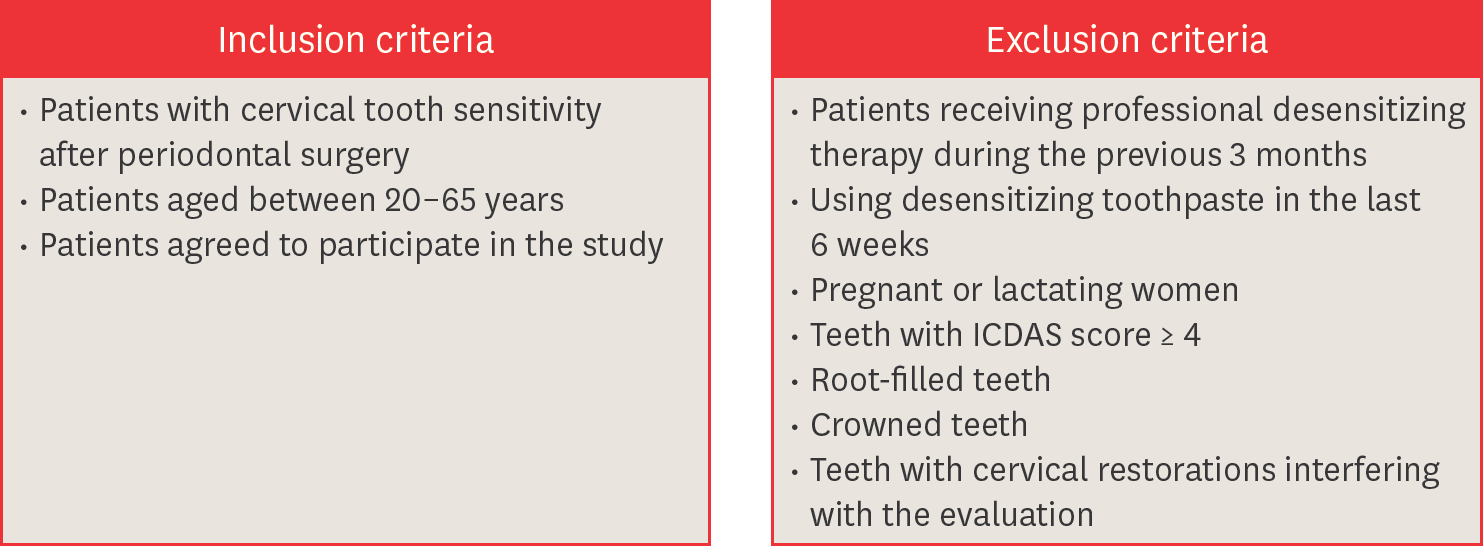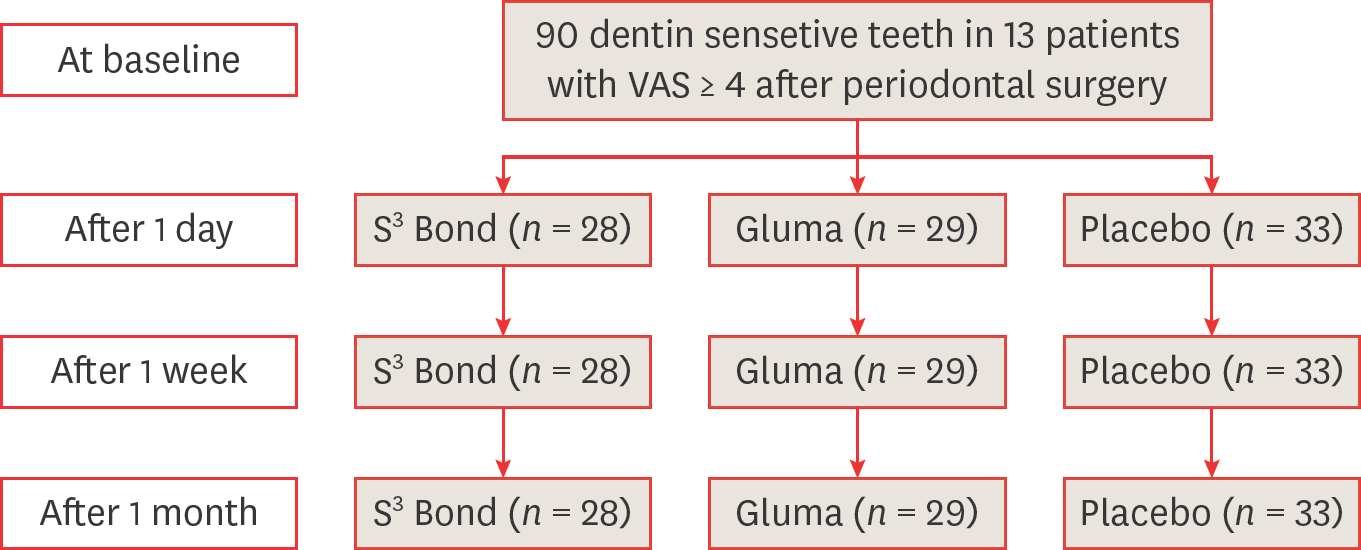Abstract
Objectives
This double-blind randomized placebo-controlled clinical trial evaluated the ability of a desensitizing agent and a self-etch adhesive on cervical dentin sensitivity (CDS) after periodontal surgery.
Materials and Methods
Ninety hypersensitive teeth of 13 subjects were included in the study. After periodontal surgery, the teeth of each posterior sextant treated with one of the following materials: G1: Clearfil S3 Bond (Kuraray Dental), G2: Gluma Desensitizer (Heraeus Kulzer), and G3: placebo (water). The sensitivity was assessed using evaporative stimuli before treatment (baseline, T0), 1 day after treatment (T1), after 1 week (T2), and 1 month (T3) according to visual analog scale (VAS).
Results
Following the treatment, all the 3 groups showed significant reduction of CDS in T1 compared to T0. Reduction of CDS between T1 and T2 was observed only in G1 but there was no significant difference between T2 and T3 in this group. Although we observed a significant difference in T3 compared to T1 and T2 in G2 and G3, comparison of treatment groups in each assessment time showed a significant difference only in T3. According to paired comparison, this was due to the difference between G2 and G3.
References
1. Davari A, Ataei E, Assarzadeh H. Dentin hypersensitivity: etiology, diagnosis and treatment; a literature review. J Dent (Shiraz). 2013; 14:136–145.
2. Canadian Advisory Board on Dentin Hypersensitivity. Consensus-based recommendations for the diagnosis and management of dentin hypersensitivity. J Can Dent Assoc. 2003; 69:221–226.
3. Splieth CH, Tachou A. Epidemiology of dentin hypersensitivity. Clin Oral Investig. 2013; 17(Supplement 1):S3–S8.

5. Braennstroem M, Astroem A. A study on the mechanism of pain elicited from the dentin. J Dent Res. 1964; 43:619–625.

6. Yoshiyama M, Suge T, Kawasaki A, Ebisu S. Morphological characterization of tube-like structures in hypersensitive human radicular dentine. J Dent. 1996; 24:57–63.

7. Ling TY, Gillam DG. The effectiveness of desensitizing agents for the treatment of cervical dentine sensitivity (CDS)–a review. J West Soc Periodontol Periodontal Abstr. 1996; 44:5–12.
8. Lin PY, Cheng YW, Chu CY, Chien KL, Lin CP, Tu YK. In-office treatment for dentin hypersensitivity: a systematic review and network meta-analysis. J Clin Periodontol. 2013; 40:53–64.

9. Fu B, Shen Y, Wang H, Hannig M. Sealing ability of dentin adhesives/desensitizer. Oper Dent. 2007; 32:496–503.

10. Grégoire G, Joniot S, Guignes P, Millas A. Dentin permeability: self-etching and one-bottle dentin bonding systems. J Prosthet Dent. 2003; 90:42–49.

11. Tsuchiya S, Nikaido T, Sonoda H, Foxton RM, Tagami J. Ultrastructure of the dentin-adhesive interface after acid-base challenge. J Adhes Dent. 2004; 6:183–190.
12. Yu X, Liang B, Jin X, Fu B, Hannig M. Comparative in vivo study on the desensitizing efficacy of dentin desensitizers and one-bottle self-etching adhesives. Oper Dent. 2010; 35:279–286.
13. Al-Sabbagh M, Beneduce C, Andreana S, Ciancio SG. Incidence and time course of dentinal hypersensitivity after periodontal surgery. Gen Dent. 2010; 58:e14–e19.
14. Nishida M, Murayama Y, Nomura Y, Asano K, Ujimoto F, Shinoda S, Sakan J, Uchida A, Katamsi D, Yokomizo I. Hypersensitivity of the exposed root surface after the surgical periodontal treatment. Nihon Shishubyo Gakkai Kaishi. 1976; 18:502–510.

15. Lin YH, Gillam DG. The prevalence of root sensitivity following periodontal therapy: a systematic review. Int J Dent. 2012; 2012:407023.

16. Absi EG, Addy M, Adams D. Dentine hypersensitivity. A study of the patency of dentinal tubules in sensitive and non-sensitive cervical dentine. J Clin Periodontol. 1987; 14:280–284.

17. Duran I, Sengun A. The long-term effectiveness of five current desensitizing products on cervical dentine sensitivity. J Oral Rehabil. 2004; 31:351–356.

18. Gillam DG, Coventry JF, Manning RH, Newman HN, Bulman JS. Comparison of two desensitizing agents for the treatment of cervical dentine sensitivity. Endod Dent Traumatol. 1997; 13:36–39.

19. Ide M, Morel AD, Wilson RF, Ashley FP. The rôle of a dentine-bonding agent in reducing cervical dentine sensitivity. J Clin Periodontol. 1998; 25:286–290.
20. Prati C, Cervellati F, Sanasi V, Montebugnoli L. Treatment of cervical dentin hypersensitivity with resin adhesives: 4-week evaluation. Am J Dent. 2001; 14:378–382.
21. Swift EJ Jr, May KN Jr, Mitchell S. Clinical evaluation of Prime & Bond 2.1 for treating cervical dentin hypersensitivity. Am J Dent. 2001; 14:13–16.
22. Kakaboura A, Rahiotis C, Thomaidis S, Doukoudakis S. Clinical effectiveness of two agents on the treatment of tooth cervical hypersensitivity. Am J Dent. 2005; 18:291–295.
23. Inoue G, Tsuchiya S, Nikaido T, Foxton RM, Tagami J. Morphological and mechanical characterization of the acid-base resistant zone at the adhesive-dentin interface of intact and caries-affected dentin. Oper Dent. 2006; 31:466–472.

24. Nikaido T, Inoue G, Takagaki T, Waidyasekera K, Iida Y, Shinohara MS, Sadr A, Tagami J. New strategy to create “Super Dentin” using adhesive technology: reinforcement of adhesive–dentin interface and protection of tooth structures. Jpn Dent Sci Rev. 2011; 47:31–42.

25. Polderman RN, Frencken JE. Comparison between effectiveness of a low-viscosity glass ionomer and a resin-based glutaraldehyde containing primer in treating dentine hypersensitivity–a 25.2-month evaluation. J Dent. 2007; 35:144–149.

26. Aranha AC, Pimenta LA, Marchi GM. Clinical evaluation of desensitizing treatments for cervical dentin hypersensitivity. Braz Oral Res. 2009; 23:333–339.

27. Qin C, Xu J, Zhang Y. Spectroscopic investigation of the function of aqueous 2-hydroxyethylmethacrylate/glutaraldehyde solution as a dentin desensitizer. Eur J Oral Sci. 2006; 114:354–359.

28. Kawasaki A, Ishikawa K, Suge T, Shimizu H, Suzuki K, Matsuo T, Ebisu S. Effects of plaque control on the patency and occlusion of dentine tubules in situ. J Oral Rehabil. 2001; 28:439–449.
Figure 1.
Inclusion and exclusion criteria. ICDAS, International Caries Detection and Assessment System.

Table 1.
Mean visual analog scale (VAS) scores for each treatment group within each assessment time
The data were presented as mean ± standard deviation.
Same superscript letter indicates no significant differences between groups as per the results of pairwise multiple comparisons (p < 0.05). Lowercase superscripts denote differences in each row (horizontal). Uppercase superscripts denote differences in each column (vertical).




 PDF
PDF ePub
ePub Citation
Citation Print
Print



 XML Download
XML Download